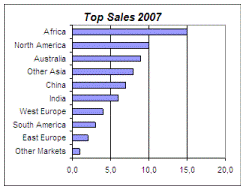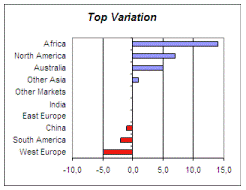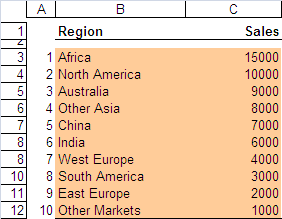
www.officehelp.biz
 www.officehelp.biz |
Office Tutorials & Software Solutions |
| Specializing in Advanced Spreadsheet & Office Macro Solutions. |
|
| ExMiniTools - Utilities Toolbar for Microsoft® Excel® |
| Application | Microsoft Excel | Version | 2.00 |
| Author | OfficeHelp | ||
| Tested on versions: | 2000 (9.0), XP (10.0), 2003 (11.0), 2007 (12.0), 2010 (14.0), 2013, 2016 - should work on any version from Office 97 | ||
|
||
| Contact Us for Support | Main Page | FREE DEMO |
MANUAL - Toolbar Buttons & Worksheet Functions Reference
|
|
|
|
Index |
Download FREE Demo |
|
|
Copy/Paste a range of cells without Excel adjusting the cell references in formulas within it. Follow these steps:
1) Select a contiguous range of cells and click on the Memorizes Selected Cells (
) Toolbar button.
- Do not use Excel regular COPY. You need to use this specific toolbar button.
2) Select the Top Left cell on the intended Paste range. Click on the Paste Exact Formulas (
) Toolbar button to paste the exact formulas of the original range.
3) The formulas on the new "pasted" range are EXACTLY as the original one. No adjustments will be done the the formulas and cell references.
This feature can be tested with our FREE demo. Click here to download.
This innovative feature is intended to provide auto-sorted tables in Excel, really useful to create rankings and Rank charts:
Create Rankings (Top Sellers) |
Actual to Budget variations |
While you can manually sort ranges in Excel, this is a manual and tiresome process, especially if it has to be done regularly (daily, weekly or monthly reports) and on several tables. It would be much easier if you could just update the data and recalculate to reorder the table!
Instead of sorting the original table, we create a new one (linked to the original) that will always sort itself when recalculated: (Row and Column headings shown):
Original Data Table |
Sorted Table |
On the sorted table, we need a column to indicate each row order number (A) and a cell to indicate the sort order (TRUE = Ascending, FALSE = Descending). For each cell, enter a call to the TopN() function:
=TopN($C$14:$C$23; A34; "C";$H$8)
The exact syntax of this function is:
= TopN (nRange, TopNVal, ReturnCol, SortType)
- nRange: Range of cells for the Ranking. Can have only ONE column.
- TopNVal: Index number in Ranking to be returned (1 for first, 2 for second,…)
- ReturnCol: Column number were to fetch the return value
- SortType: Sort Order for the cell values:
- TRUE: ASCENDING
- FALSE: Descending
This function will return the Nth member of the original table, sorted by the indicated nRange. So, to retrieve the 3rd largest region in 2007, we need to define the function as:
- nRange: $C$3:$C$$12 (values for 2007)
- TopNVal: 3 (as a number, for 3rd) or a reference to the order column on the sorted table (A5)
- ReturnCol: "B" to return the region name or "C" to return the region value.
- SortType: TRUE (ascending)
So to create the Sorted table we use the the same function (as above) and only change the ReturnCol parameter in order to retrieve the region labels and value.
It is also possible to return secondary values based on another column sort order (like returning variances to Budget and Last Year based on the “variance to Budget” sort order – the variances to Last Year will not be retrieved sorted by itself by sorted by the “variance to Budget” values). Creating the new column is as easy as copying one of the existing ones (either labels or values) and changing the ReturnCol parameter (the column to be returned).
In the example above, a 3rd column could be added to the Sorted Table to indicate the variation to 2006, keeping it sorted by 2007 values. The only change would be, again the ReturnCol parameter, that in this case would have to be set to "E", retrieving the Variation column of the Original Data Table. The final Sorted Table would use these formulas on the first row (3):
These formulas (for the first row), could then be dragged down until the 10 rows were filled.
This feature can be tested with our FREE demo. Click here to download.
Compare the formulas within 2 cell ranges. Follow these steps:
1) Select a contiguous range of cells and click on the Memorizes Selected Cells (
) Toolbar button.
- Do not use Excel regular COPY. You need to use this specific toolbar button.
2) Select the Top Left cell on the intended comparison range. Click on the Formula Comparison (
) Toolbar button.
3) Each cell on the comparison range will be compared with its similar cell on the original range. Cells will be painted according to the comparison results:
- YELLOW: Same value as reference cell, but formula is different
- RED: Different value and formula compared to reference
- NONE: No difference to reference (same value and formula)
This feature can be tested with our FREE demo. Click here to download.
Apply Backgrounds to Ranges / Tables
Apply alternate backgrounds (Row/Column) in a single click - Much easier to read, specially in print. Just Select & Apply
1) Format cell A1 (on the active worksheet) with the desired background color. This cell will be the reference
2) Apply the desired background pattern. Cell A1 background format will be applied to the selected range:
- Alternate Rows (
) - Applies a background color to alternate rows of the current selection.
- Alternate Columns (
) - Applies a background color to alternate columns of the current selection.
- Chess Pattern (
) - Applies a background color to alternate cells of the current selection, creating a “Chess Pattern”.
3) The selected range will be formatted with the desired pattern (example: Alternate Rows pattern):
This feature can be tested with our FREE demo. Click here to download.
Automatically repair broken function links from AddIns
Excel treats external functions residing in AddIns as links. Therefore, when the file using them is saved, it will add the full path the AddIn to the function call in the cells:
Entered in File: =topn($C$14:$C$23; A32; "C";$H$8)
After Saving: =C:\Program Files\AddIn\ThisAddIn.xla!topn($C$14:$C$23; A32; "C";$H$8)
This is a real problem if the file is later opened in a different computer where the AddIn resides in a different disk location, as Excel will consider the link broken and will not calculate the AddIn functions until the disk path is removed. This can be very frustrating as some files may have thousands of function calls needing cleaning. This is a common scenario for corporate users using Excel Addins to retrieve data from their corporate databases and Business Intelligence or Financial applications.
To use this feature, just open the file needing the restore and click the
 button. The Toolbar will check ALL cells with functions on the active
workbook and restore the AddIn function calls in all cells needing it. There
is no need to select ranges or sheets, it will apply to the whole active
workbook. Once done, just save the file to disk.
button. The Toolbar will check ALL cells with functions on the active
workbook and restore the AddIn function calls in all cells needing it. There
is no need to select ranges or sheets, it will apply to the whole active
workbook. Once done, just save the file to disk.
This feature can be tested with our FREE demo. Click here to download.
Remove all #Errors from a Range
This feature is intended to clean tables of error cells (like #Div/0) before copying to Word or printing. Cells with errors (shown starting with a # in Excel) will be ERASED permanently, because this errors may cause other cells (like SUMs) to also show errors instead of calculating the remaining values. It is therefore advisable to use it on a copy of the original sheet.
To use it select an range of cells with the mouse and click on the  button. The toolbar will check each cell in the selected range and, if it
contains an Excel calculation error, it will be erased. The final range will
only have values and empty cells, resulting in a “clean” table for printing
purposes.
button. The toolbar will check each cell in the selected range and, if it
contains an Excel calculation error, it will be erased. The final range will
only have values and empty cells, resulting in a “clean” table for printing
purposes.
This feature can be tested with our FREE demo. Click here to download.
1 Click access to Excel commands
SAVE TIME with direct, 1 click access to the "hidden" Excel commands. This buttons will invoke the regular Excel commands performing the same functions.
|
|
|
| This feature can be tested with our FREE demo. Click here to download. |
Install an Excel AddIn (not necessary for the DEMO, only for the full product)
An Excel AddIn is an extension to Excel and, once installed, will load every time Excel is loaded, becoming “part” of Excel until it is deliberately uninstalled. Learn how to install and manage them on all versions of Excel from 97 to 2007.
Click here for an illustrated article on How to Install Excel AddIns.
| TOOLBAR BUTTONS |
WORKSHEET FUNCTIONS |
|||||
|
|
Automatic Sorting & Ranking
IndexInRankingNum (nRange, SearchVal, SortType) Returns the Index of a given value in a sorted table (Ranking Index)
IndexInRankingTxt (nRange, SearchVal, SortType) As above but for text values. Orders are performed as text, not numeric values, so 10 comes before 9 because it starts with a 1. Returns the Nth value of a ranking (ordered) Range. The Range has to be single column. Can return any column (even outside of the Range), like Label or Value.
CountUnique (nRange) Returns the number of different unique values in a given range. Like Excel standard Count() function but EXCLUDING repeats.
Click here for a FREE DEMO for the Sheet Functions Date Functions GetEasterDate (Year) Returns the date of the Easter Day for the given year. Ex: GetEasterDate(2001) will return 15 of April 2001 AddWorkingDays (StartDate, NDays, Holidays) Adds Working Days to a Start Date, discounting Weekends and Holidays into consideration. Weekend tracking is automatic but Holidays have to be supplied as a comma separated list of dates. Ex: AddWorkingDays(1/1/2006, 15, “'1/1/2006, 1/4/2006”) will return 1/20/2006 |
|||||
|
||||||
| Contact Us for Support | Main Page | FREE DEMO |
(c) 2004 - 2025 OfficeHelp.Biz